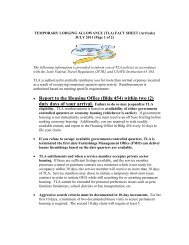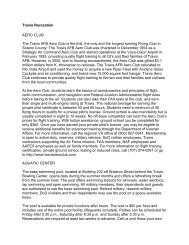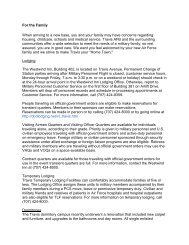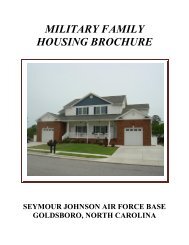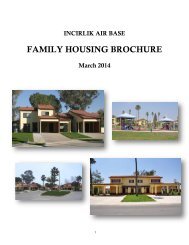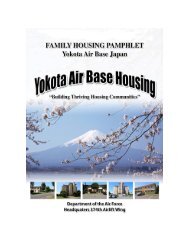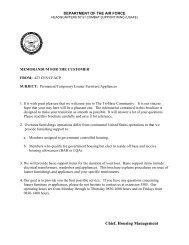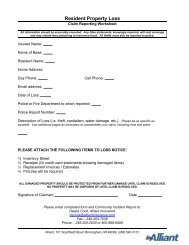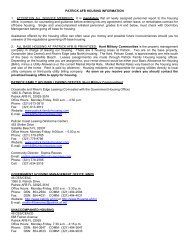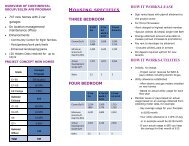San Antonio Military Telephone Directory - Air Force Housing
San Antonio Military Telephone Directory - Air Force Housing
San Antonio Military Telephone Directory - Air Force Housing
Create successful ePaper yourself
Turn your PDF publications into a flip-book with our unique Google optimized e-Paper software.
Defense Switched Network<br />
DSN Information<br />
DEFENSE INFORMATION SYSTEMS AGEncy MISSion<br />
“To plan, engineer, develop, test, manage programs, acquire, implement, operate and<br />
maintain information systems for C4I and mission support under all conditions of peace<br />
and war.”<br />
DEFENSE INFORMATION SYSTEMS AGEncy MANDATE<br />
The Defense Information Systems Agency is transforming the way Department of Defense<br />
users move, share and use information. All DoD personnel need information whether they<br />
maintain or fly aircraft, operate a periscope, move a platoon, perform surgery, process<br />
transactions or any of hundreds of other jobs supporting our country’s defense. As the<br />
manager, DISA is integrating hardware and software and constructing a common operating<br />
environment to sustain warfighters need for information anytime, anywhere. The pillars of<br />
the system are the Defense Information System Network, the Defense Message System,<br />
the Global Command and Control System and the Global Combat Support System. DISA is<br />
also helping protect against, detect and react to threats to both its information infrastructure<br />
and information sources.<br />
DEFENSE INFORMATION SYSTEMS NEtwork VISion<br />
“DISN will be the preeminent provider of information systems delivery support to our<br />
WARFIGHTERS and others as required by the DoD, under all conditions of Peace and War.”<br />
Defense Switched Network (GS23)<br />
Branch Chief: Howard Osman<br />
Network Services Location: Defense Information Systems Agency<br />
Please direct questions about the Dsn <strong>Directory</strong> to:<br />
DSN: (312) 381-0306<br />
The URL for the Dsn <strong>Directory</strong> is: http://dsnbbs.ncr.disa.mil.<br />
A BRIEF DEScription OF THE DEFENSE SwitchED NEtwork<br />
The DSN is a primary information transfer network for the Defense Information Systems<br />
Network (DISN). The DSN provides the worldwide non-secure voice, secure voice, data,<br />
facsimile and video teleconferencing services for DoD Command and Control (C2) elements,<br />
their supporting activities engaged in logistics, personnel, engineering and intelligence,<br />
as well as other Federal agencies.<br />
In 1982, the DSN was designated by the Office of the Secretary of Defense and the Joint<br />
Chiefs of Staff (JCS) as the provider of long-distance communications service for the DoD.<br />
The DSN is designated as a primary system of communication during peacetime and during<br />
periods of crisis, pre-attack, non-nuclear and post-attack phases of war. The network<br />
assures non-blocking service for users with flash and flash override precedence capabilities.<br />
Key users include the National Command Authorities, Commanders in Chief (CINCs) of the<br />
Unified Commands and strategic and tactical subordinate commanders.<br />
The DSN consists of four subsystems: Switching, Transmission, Timing and Synchronization<br />
and Network Administration and Management. The DSN Switching Subsystem consists<br />
of multi-function, stand alone tandem, end office and remote switching units. Using the<br />
transmission, timing and control elements of the DISN, the switching units interconnect<br />
all military locations worldwide and provide end-to-end long-distance common user and<br />
dedicated voice, secure voice, data and video services worldwide.<br />
In addition to non-secure voice, data and video services, the DSN provides transmission,<br />
switching and support services for Secure <strong>Telephone</strong> Units, Third Generation (STU-IIIs),<br />
the Secure Terminal Equipment (STE), the Defense RED Switch Network (DRSN), dial-up<br />
alternative routing for the Unclassified but Sensitive Internet Protocol (IP) Router Network<br />
(NIPRNet) and the Secret IP Router Network (SIPRNet). The DSN also provides access to<br />
the Government Emergency <strong>Telephone</strong> System (GETS).<br />
DSN Table of Contents<br />
Defense Information Systems Agency Mission..............12<br />
Defense Information Systems Agency Mandate.............12<br />
Defense Information Systems Agency Network Vision...12<br />
A Brief Description of the<br />
Defense Switched Network..........................................12<br />
Geographical Listing.......................................................12<br />
Foreword..........................................................................12<br />
National Communications<br />
System Voice Precedence System..............................12<br />
What Category of Network Customer are You...............13<br />
Who is Listed in the DSN <strong>Telephone</strong> <strong>Directory</strong>.............13<br />
DSN <strong>Telephone</strong> <strong>Directory</strong> Distribution............................13<br />
Network Recording and Signal Tones.............................13<br />
Calling Procedures..........................................................14<br />
Voice <strong>Telephone</strong> Calls (31X).......................................14<br />
Data <strong>Telephone</strong> Calls (50X & 51X)..............................14<br />
Conference Calls.........................................................14<br />
Calls to Commercial Toll-Free Numbers....................14<br />
Call Assistance............................................................14<br />
Inter-Area Calling........................................................14<br />
New or Additional Service...........................................14<br />
Special Services..........................................................14<br />
User-Provided Equipment...........................................14<br />
Reporting <strong>Telephone</strong> Trouble......................................14<br />
Reporting Unsatisfactory Service...............................14<br />
Acronym List....................................................................15<br />
Appendix A – DSN <strong>Telephone</strong> Listing Request...............15<br />
Appendix B – Instructions for Accessing the<br />
DSN Web Page.............................................................15<br />
Appendix C – State and Territory Abbreviations............15<br />
Appendix D – Country Abbreviations.............................15<br />
Appendix E – List of DISA Field Offices..........................15<br />
Appendix F – Time Zone Chart........................................11<br />
DSN General Information<br />
GEographical LISting<br />
Alaskan Section<br />
DSN Area Code 317, 217, 507 and 517<br />
Australian Section<br />
DSN Area Code 715<br />
Canadian Section<br />
DSN Area Code 319, 219, 509 and 519<br />
Central Command Section<br />
DSN Area Code 318, 218, 508 and 518<br />
conus Section<br />
DSN Area Codes 312, 212, 502 and 512<br />
European Section<br />
DSN Area Code 314, 214, 504 and 514<br />
Pacific Section<br />
DSN Area Code 315, 215, 505 and 515<br />
FOREword<br />
The Defense Switched Network <strong>Telephone</strong> <strong>Directory</strong> is<br />
divided into six geographical listings: Alaska, Canada, the<br />
Continental United States (CONUS), Europe, the Pacific and<br />
Central Command.<br />
The Defense Switched Network <strong>Telephone</strong> <strong>Directory</strong> cannot<br />
list all subscriber numbers. It does provide a facility or<br />
organizational central contact telephone number, which<br />
is generally an operator assistance number. If you do not<br />
have the current number for the party to whom you wish to<br />
speak, use the central contact number to obtain your party’s<br />
number or to have your call forwarded.<br />
Listings in the directory are in two formats. Both proper name<br />
and facility type are used for ease of location of posts, bases,<br />
camps and stations. For example, Camp (CP) Smith, is listed<br />
as Smith, Camp and CP Smith; the Naval <strong>Air</strong> Facility at Atsugi is<br />
listed as Atsugi Naval <strong>Air</strong> Facility and Naval <strong>Air</strong> Facility- Atsugi;<br />
and Lackland <strong>Air</strong> <strong>Force</strong> Base (AFB) is listed as Lackland AFB and<br />
AFB, Lackland. Units identified by numerical designations are<br />
listed in numerical order, not by unit type. For example, the 121st<br />
Tactical Fighter Wing (TFW) is listed only as the 121st TFW.<br />
The Defense Switched Network <strong>Telephone</strong> <strong>Directory</strong> is<br />
in alphabetical order by area code (e.g. Alaska, Canada,<br />
CONUS). The seven-digit operator assistance telephone<br />
number is sorted numerically.<br />
NATIONAL COMMUNICATIONS SYSTEM<br />
voicE PRECEDEncE SYSTEM<br />
The National Communications System (NCS) Voice Precedence<br />
System, which was established by NCS Memorandum<br />
1-70, February 14, 1970, is for use by all authorized<br />
users of DoD voice communications facilities. Since the<br />
effectiveness of the system depends on the cooperation<br />
of the people authorized to use it, users must:<br />
12 2012/2013 Joint Base <strong>San</strong> <strong>Antonio</strong>




